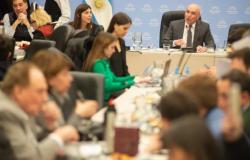(ADN).- For decades, when Argentina resumed vaccination against foot-and-mouth disease (which was actually only interrupted for a few months in 2000), Patagonia has been considered a “region free of foot-and-mouth disease without vaccination,” since There – due to climatic and geographical conditions – it is not necessary to apply the inoculum to cattle.
This division of the country into two health zones (with and without vaccination) has also had consequences on trade, since bone-in beef cannot enter the south of the country from the north, since according to health rules it could carry the virus.
This especially bothers two actors. On the one hand, consumers in the Patagonian region (including many tourists who visit it), who usually have to pay much more expensive barbecue there than in the rest of Argentina, since the region only has 2.5 million heads and then the supply of that cut is insufficient. On the other hand, those who feel harmed are the livestock producers who, including the Colorado River, cannot sell their ribs on the other side of the Patagonian Sanitary Barrier. Those who complain the most are those from La Pampa, who have expressly asked the national government to eliminate this internal barrier.
The temptation to be able to sell barbecue from the Patagonian side is so great (especially in cities like Bariloche) that from time to time attempts to smuggle ribs are thwarted. And all this happens within Argentina itself.
This situation, which beyond some flexibility has remained intact since March 2001, could begin to be altered in the coming months if Senasa (National Agri-Food Health and Quality Service) incorporates the recent recommendations made by the Organization into national health legislation. World Animal Health Organization (WHOSA) at its annual meeting in Paris, held this past week. Because? Because this multilateral forum made up of 183 countries reformed chapter 8.8.4 of its Terrestrial Code, which is like the international digest for the management of livestock diseases, to facilitate the trade of certain products between foot-and-mouth disease-free zones without vaccination (such as Patagonia ) and areas with vaccination (like the rest of the country).
In that recommendation, the WHOA attempted to break down these types of trade barriers that use FMD vaccination as an excuse. This is the discrimination that Argentina has suffered for almost 100 years, as the country is prohibited from freely exporting its bone-in beef to many countries in the so-called “non-foot-and-mouth disease circuit,” such as the United States, Canada, South Korea or Japan. This same recommendation should be transferred to the interior of countries that, such as Argentina or Brazil, have areas where vaccination against zoonoses has stopped.
Bichos de Campo reported on these recommendations: At its annual meeting in Paris, the WHOA launched a new recommendation in which it indicates that there is no risk of moving food between countries (and within countries) with these two different health statuses. This list of foods that should no longer be penalized for being in an area with vaccination includes “UHT milk and derivatives, thermo-processed meat, protein foods, jellies, embryos, skins and leather, and extracts for pet food.” The curious thing is that chilled or frozen beef was not included there. This leaves out the barbecue from La Pampa that wants to enter Patagonia.
But what no one has realized yet is that the recommendation of the International Organization does include live animals. And this suddenly opened the door for the Patagonian health barrier to be made more flexible, if not for bone-in beef cuts, then for northern bovines, which theoretically could now be “exported” to the protected area, to be slaughtered in some of the refrigerators enabled in said region.
That would allow the pampas roasts to finally enter Patagonia. It would be something like a “Trojan cow”: Under the new recommendations of the WHOA, bone-in meat, such as the sought-after ribs, could cross the iron barrier within each animal.
This was confirmed this Saturday in statements to the Rivadavia Agro program by the failed Argentine candidate to preside over the OMSA, veterinarian Luis Barcos, who lost a close election with the Frenchwoman Emmanuelle Soubeyran and was unable to alter the reign of the Gauls in that organization.
“What was adopted has been discussed for nine years to facilitate trade. One of the issues was being able to move animals from a country free of foot-and-mouth disease with vaccination to one without vaccination. There is all the scientific knowledge for this movement to be safe,” Barcos validated. For the expert, who is the WHO representative on the American continent, this type of relaxation of health rules “serves to avoid the black market.”
The former president of Senasa in the 90s regretted that the OMSA had not been able to extend this facilitation to beef, prolonging an old restriction. “Today meat from countries that are free with vaccination has to undergo a certain treatment, as if it were from a country infested (by foot and mouth disease). All of this must be put on the discussion table,” he claimed.
The truth is that, with subtlety, the WHOA recommended to its associated countries (and Argentina has been one since the beginning, a hundred years ago) that they apply this new recommendation and that now Senasa should decide what to do with the Patagonian Sanitary Barrier. Or rather, if the international resolution is accepted, it should begin to allow farms from the north of the country to enter the protected region without vaccination. With the ribs and the roast inside the animals, of course.
The agency’s officials have already taken note of the new situation, but they know that everything will depend on a political decision, since there are many interests at stake. For years, Patagonia has resisted any relaxation of the Sanitary Barrier, and ranchers in that region usually have the support of their governors. But in La Pampa there is also a very strong lobby in the opposite direction. Even deputies from that province, such as PRO member Martín Ardohain, have complained about this matter to the “deregulatory” government of Javier Milei and presented separate bills.
To adapt the national regulations to the new recommendations of the WHOA and allow the entry of roasted animals into Patagonia within live animals, Senasa should modify Resolution 1259/2023, which in its article 5 is blunt: by redefining the zones internal conditions with and without vaccination, provides that “the entry into the Patagonia, Patagonia North A and Calingasta Valleys of live animals susceptible to Foot and Mouth Disease from areas with foot and mouth vaccination is prohibited.”
*Note produced by the Bichos de Campo portal.






